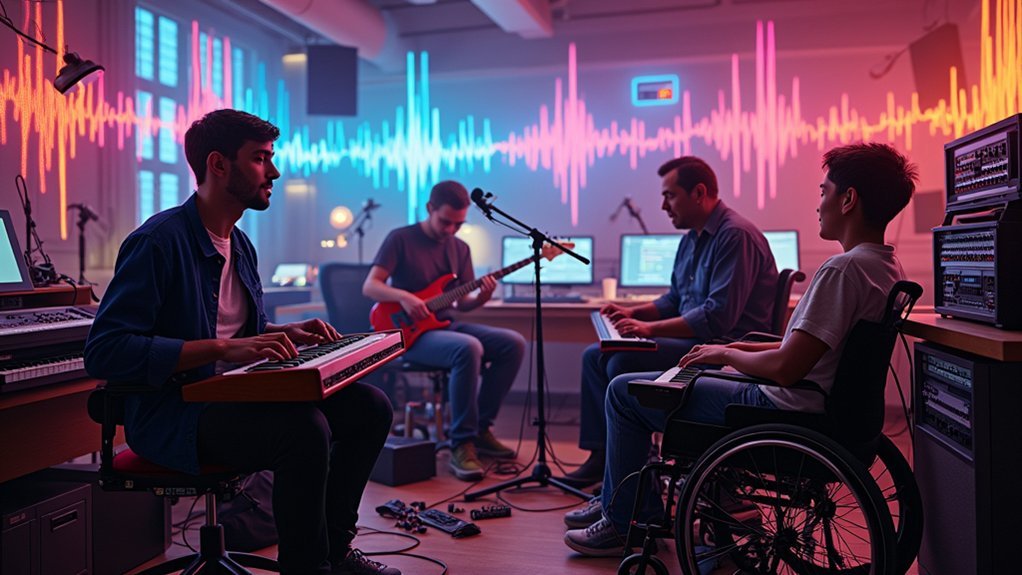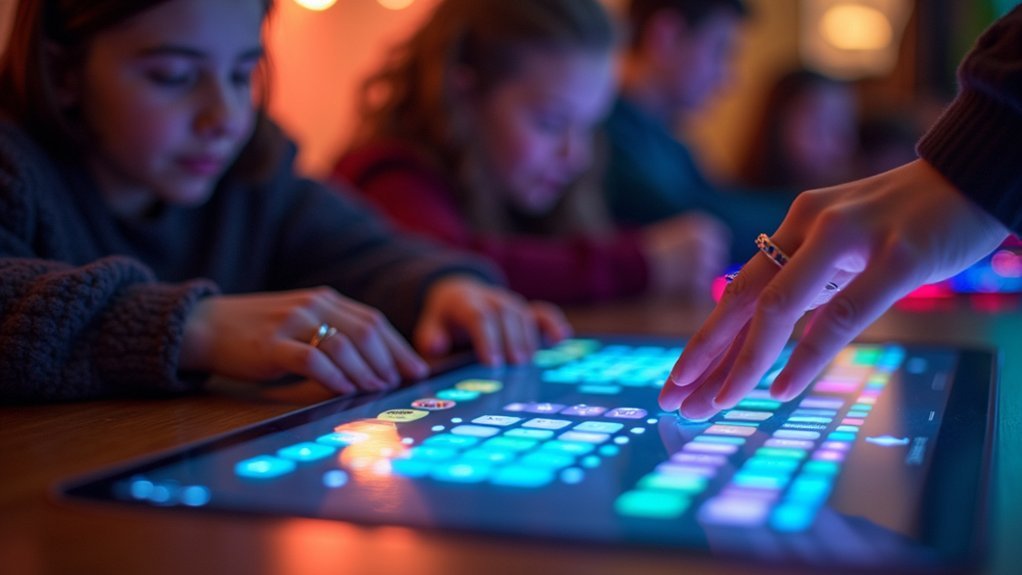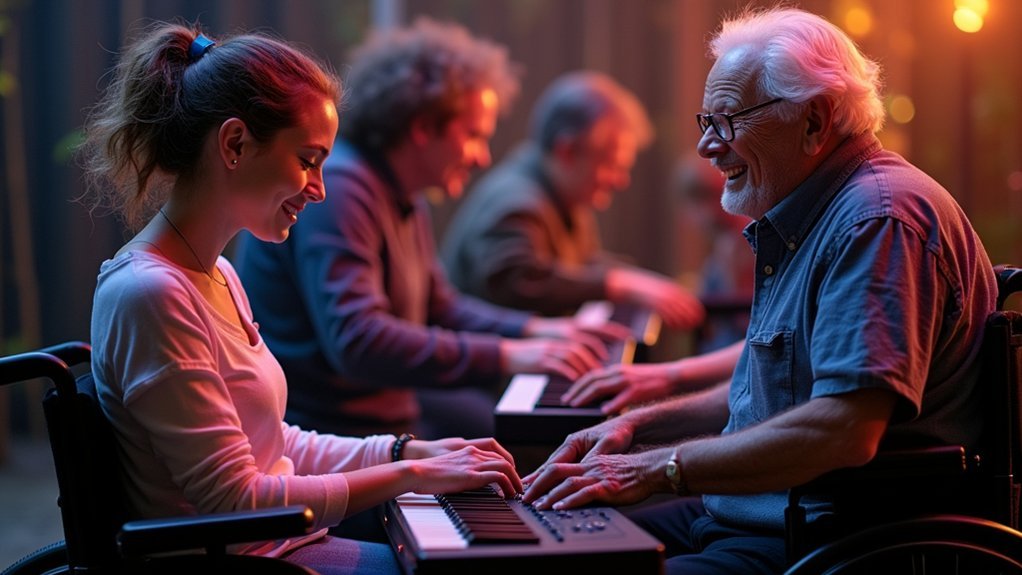Adaptive music technology eliminates disability barriers through various innovative solutions. You’ll find gesture-based instruments like Soundbeam that translate body movements into music, eye-tracking systems like EyeHarp for hands-free composition, and brain-computer interfaces that convert neural signals into musical expressions. Voice-controlled systems and customizable interfaces like Skoog provide additional pathways for creative expression. Low-cost DIY options using Arduino or Makey Makey enable personalized instrument creation. Discover how these technologies are transforming musical possibilities for everyone.
The Social Model of Disability in Music Creation

While traditional music technology has often overlooked accessibility concerns, the social model of disability offers a powerful framework for reimagining music creation. This approach recognizes that societal structures—not individual impairments—create barriers to musical participation.
When you design adaptive music instruments with this mindset, you prioritize user control and creative expression over conformity to conventional standards. Universal Design principles help identify and eliminate disabling features in commercial instruments, leading to innovations that benefit musicians of all abilities.
This shift in perspective transforms music education into an inclusive space where diverse talents collaborate without artificial limitations.
Gesture-Based Instruments for Limited Mobility
When traditional instruments present physical barriers, gesture-based technologies open new pathways to musical expression for people with limited mobility. The Soundbeam transforms your body movements into music, letting you create melodies with simple gestures regardless of dexterity limitations.
Music transcends physical limitations through gesture-based technologies, empowering creative expression beyond traditional instrumental constraints.
For those with severe physical disabilities, Brainfingers converts facial movements into MIDI signals, enabling you to control music software without traditional physical interaction. The EyeHarp takes this further by tracking eye movements, allowing musical composition through sight alone.
These accessible music solutions extend to tactile instruments like the Skoog, featuring pressure-sensitive buttons that respond to even minimal touch.
With gesture recognition software detecting movements from various body parts, you’re no longer limited by conventional playing techniques—your creative potential exists beyond physical constraints.
Eye-Tracking Technologies for Hands-Free Composition
For musicians who can’t use traditional hand movements, eye-tracking technologies have revolutionized composition possibilities by translating visual focus into musical expression.
Systems like EyeHarp track your gaze to select notes and control sounds, enabling creative musical development without physical instrument interaction.
You’ll find these tools integrate seamlessly with popular DAWs like Logic Pro and Ableton Live, making composition accessible within familiar software environments.
For disabled musicians, this technology removes significant barriers to participation in music creation.
Beyond composition, eye-tracking systems are becoming essential in music therapy settings, where they provide new channels for emotional expression.
As this technology continues to evolve, it’s opening unprecedented creative pathways for musicians who previously faced limited options for musical engagement.
Voice-Controlled Music Systems for Physical Disabilities
Voice-controlled music systems offer you powerful hands-free creation options when physical limitations prevent traditional instrument playing.
You’ll find technologies like Siri, Google Assistant, and specialized music voice recognition software transforming how musicians with disabilities compose and perform.
These vocal command interfaces democratize music-making by eliminating physical barriers, allowing creative expression through simple voice instructions rather than manual manipulation of instruments or software.
Hands-Free Creation Options
Despite traditional music production requiring physical manipulation of instruments or interfaces, innovative voice-controlled systems have revolutionized accessibility for musicians with physical disabilities. You’ll find these technologies eliminate physical barriers while preserving creative control.
- Use Google’s Voice Access or Apple’s Siri to navigate music software completely hands-free.
- Describe your musical vision verbally to AI platforms like Amper Music and instantly receive tailored compositions.
- Control editing functions, instrument selection, and playback through simple vocal commands.
- Access advanced music creation tools regardless of your motor control or dexterity limitations.
- Join a growing inclusive musical community where physical disabilities no longer limit creative expression.
Music accessibility continues advancing through these speech-driven interfaces, enabling musicians with disabilities to compose, produce, and perform with unprecedented independence.
Voice recognition technology transforms musical expression into a truly universal language.
Vocal Commands Democratize Music
While traditional music creation often demands physical dexterity, modern voice-controlled systems have transformed accessibility entirely. You can now compose, edit, and produce music simply by speaking commands, opening doors for people with disabilities who face physical barriers to traditional instruments and interfaces.
Popular voice assistants like Siri and Google Assistant integrate seamlessly with music production platforms such as Ableton Live and Logic Pro, enabling hands-free operation. These technologies allow you to control sophisticated music creation processes through simple vocal inputs.
Even specialized software like Vocaloid lets you synthesize singing performances using just your voice.
Research confirms these voice-controlled systems greatly enhance creative expression for individuals with limited motor control, democratizing music creation and fostering a more inclusive artistic community.
Customizable Touch Interfaces for Sensory Impairments

As music technology evolves, customizable touch interfaces have emerged as powerful tools for breaking down barriers faced by individuals with sensory impairments.
These innovations transform music production by creating access options that respond to each person’s unique capabilities.
- Makey Makey technology turns everyday objects into musical instruments through responsive touch interfaces
- Skoog’s tactile buttons with varying pressure sensitivity accommodate users with limited motor control
- Haptic feedback systems allow visually impaired musicians to “feel” the music they’re creating
- Gesture-recognition platforms translate body movements into musical expression, enhancing performance possibilities
- User-centered design processes incorporate direct input from disabled musicians, ensuring truly accessible technology
You’ll find these adaptable interfaces create new pathways for creative expression, regardless of sensory limitations, putting music-making within everyone’s reach.
Brain-Computer Interfaces in Musical Expression
You’ve likely witnessed the revolutionary impact of neural signal translation systems, which convert brain activity into musical commands for those with physical disabilities.
Today’s thought-controlled musical instruments represent a breakthrough in accessibility, allowing performers to compose and play music using only their neural activity.
These BCI technologies integrate seamlessly with standard music software, enabling you to adjust tempo, control dynamics, and express musical ideas without physical movement.
Subheading Discussion Points
Because traditional musical instruments require physical interaction, musicians with severe mobility limitations have historically faced significant barriers to expression.
Brain-computer interfaces (BCIs) are revolutionizing this landscape by creating direct pathways between thoughts and music technology.
- BCIs decode neural signals related to musical intent, translating them into real-time sound generation.
- People with disabilities can control virtual instruments using only their thoughts.
- Technologies like Brainfingers convert facial movements into musical commands for those with limited motor control.
- BCI applications in music therapy promote emotional well-being and social interaction.
- Research confirms BCIs enhance creative expression by bypassing physical barriers.
You’ll find these innovations particularly valuable if you’ve felt excluded from musical creation.
The technology doesn’t just offer alternative access—it opens entirely new possibilities for artistic expression that weren’t previously available to musicians with physical limitations.
Neural Signal Translation Systems
Neural Signal Translation Systems represent the cutting edge of accessible music technology, translating brain activity directly into musical expression.
These Brain-Computer Interfaces (BCIs) capture EEG signals from your brain and convert them into musical commands, allowing you to create music through thought alone.
If you’re unable to use traditional instruments due to mobility impairments, BCIs offer a revolutionary pathway to musical creation. You can select notes, adjust pitch, and control volume solely through mental activity.
Systems like Brainfingers even translate facial movements into MIDI signals, expanding your creative possibilities.
Researchers continue improving these technologies to reduce latency and increase accuracy, making live performance increasingly viable.
You’ll soon join collaborative music-making experiences, breaking barriers that once limited musical participation for people with disabilities.
Thought-Controlled Musical Instruments
While traditional instruments require physical manipulation, thought-controlled musical instruments represent a revolutionary leap in accessibility. These brain-computer interfaces (BCIs) translate neural activity into musical expression, opening doors for musicians with mobility impairments to realize their creative potential.
- The Brainfingers system converts facial movements into MIDI signals, eliminating the need for physical controls.
- BCIs provide new pathways for making music that bypass physical limitations entirely.
- Innovative projects like Skoog and EyeHarp demonstrate inclusive music-making through BCI technology.
- These interfaces empower disabled musicians to express themselves in previously impossible ways.
- By integrating BCIs into music technology, we’re expanding our definition of musicality and who can participate in performance.
You’ll find that these technologies don’t just overcome barriers—they’re challenging how we fundamentally understand musical expression and creativity.
Low-Cost DIY Adaptive Controllers Using Microcontrollers
Although professional adaptive music equipment often carries hefty price tags, microcontrollers like Arduino and Makey Makey have revolutionized accessibility by putting customizable instrument creation within reach of most budgets.
You can now build low-cost DIY adaptive controllers tailored to your specific needs by connecting various switches, sensors, and inputs to these platforms.
When you make music with these custom interfaces, you’re also developing problem-solving skills through the iterative design process. Platforms like Scratch simplify programming, making it accessible even without coding experience.
You’ll find valuable support through open-source resources and community workshops, where disabled musicians collaborate and share knowledge. This democratization of music technology fosters inclusivity by enabling personalized solutions that commercial products often can’t provide, ensuring everyone has the opportunity to express themselves musically.
Case Studies: Disabled Musicians Breaking Barriers
Beyond DIY solutions, real-world applications by disabled musicians demonstrate the transformative power of adaptive music technology. Organizations like Drake Music champion these innovations that break barriers between creativity and physical limitations.
Adaptive technology doesn’t just enable music-making—it fundamentally reimagines what musical expression can be for all bodies.
- Doug Briggs revolutionized performance with his bespoke cornet that turns valves into switches for disabled musicians.
- Anthony’s Soundbeam translations of body movements into musical expressions showcase adaptive tech’s expressive potential.
- The Skoog’s tactile, cube-shaped controller with spongey buttons enables musicians with motor impairments to create music.
- Chris Jacquin’s use of Brainfingers technology converts facial movements to MIDI signals, empowering those with limited mobility.
- The Instrument Maker Project’s custom Pure Data instruments prioritize user-driven design, ensuring technology genuinely serves musicians’ needs.
These examples prove that with the right tools, disabled musicians aren’t just participating—they’re innovating the future of musical expression.
Future Directions in Accessible Music Technology Design
As disabled musicians increasingly contribute to the evolution of musical expression, the next frontier of accessible music technology must prioritize their voices from conception to implementation.
You’ll find that leading developers are now collaborating with organizations like RAMPD to guarantee accessibility isn’t an afterthought but a foundational design principle.
The hard work of integrating eye-tracking and gesture-recognition software is creating pathways for musicians with diverse physical capabilities.
Projects like Bela represent exciting advances in new instruments that don’t require computer dependency, featuring customizable controls and intuitive interfaces.
These adaptive technologies enhance creative engagement while addressing specific needs.
For true innovation to flourish, representation matters—disabled musicians must continue to guide technology development, assuring that tomorrow’s music tools serve all creators equally.
Frequently Asked Questions
What Is the Music Technology for Special Needs?
Music technology for special needs includes tools like the Skoog tactile controller, Soundbeam movement sensors, Brainfingers facial control systems, E-Scape sequencers, and Makey Makey interfaces. You’ll find these help overcome physical limitations in music creation.
What Is Disability Friendly Technology?
Disability-friendly technology includes tools you’ve designed with disabled people’s direct input. It’s accessible, adaptable to your unique needs, and empowers you to participate independently without assumptions about your abilities limiting functionality.
How Does Music Help Those With Disabilities?
Music helps you express emotions, improve communication, and enhance cognitive function. You’ll gain confidence through creative achievements, connect with others socially, and find emotional regulation—all while experiencing joy through accessible musical engagement.
What Is Music Therapy for Individuals With Disabilities?
Music therapy for individuals with disabilities is a therapeutic approach where you’ll work with trained professionals using music to improve your functioning across physical, emotional, cognitive, and social domains through tailored, evidence-based musical interventions.
In Summary
You’ve seen how adaptive music technology isn’t just creating tools—it’s redefining what it means to be a musician. By focusing on abilities rather than limitations, these innovations are dismantling barriers that once seemed permanent. Whether you’re exploring gesture controls, eye-tracking systems, or brain interfaces, you’re part of a movement that’s making music creation universally accessible. The future you’re helping build values every person’s creative voice, regardless of physical ability.





Leave a Reply